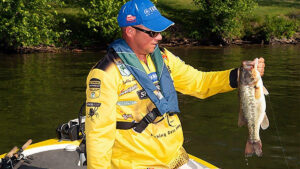Among his peers in professional tournament competition, Bobby Lane is best known for using spinnerbaits and Carolina rigs, but when water begins cooling in the autumn the Yamaha pro often changes to a topwater popper.
“Topwater popping lures are more versatile than many anglers realize,” Lane said. “That’s why I like them so much. Not only can you fish them over and around all types of cover and structure, but you can also retrieve poppers at different speeds depending on water conditions and the mood of the fish. As bass move into creeks and start feeding heavily, you’re going to encounter the fish in a variety of places and this lure allows you to cover them all without having to change lures.
“They’re great big-bass lures, too. My biggest bass on a popper weighed 9 pounds, 11 ounces but I’ve caught a lot of fish in the 6 to 8-pound range with them. When bass won’t hit other lures, you can often tempt them into striking a popper.”
Topwater poppers are made by many different lure manufacturers and many are similar in design, measuring 2 to 3 inches in length. The primary feature these lures also share is a cupped mouth that catches water and “pops” as the lure is retrieved.
“Bass are normally active in the morning as they feed on shad near the surface, and a popper imitates those shad perfectly,” Lane said. “It doesn’t really matter where the shad are, either, because you can fish a small topwater popper like this on points, over submerged vegetation and breaklines, around rocks and logs or along riprap.
“In regards to depth, you can work a popper over depths up to 20 feet, but I usually prefer water less than 10 feet deep. Being from Florida, I’m accustomed to fishing over and around submerged vegetation which is probably where I use a popper most often.”
Another aspect of the topwater popper’s versatility comes in the variety of ways the lure can be retrieved. Its action comes from rod tip movement and Lane normally begins his retrieve cadence by popping the lure two or three times, pausing it momentarily and popping it again as he moves it by his target.
“That’s really the basic way to fish a topwater popper,” Lane said. “But if that doesn’t produce any results, you can pop the lure a little faster without stopping. If the water is cooler, you can try just the opposite; only popping the lure once and then letting it sit motionless for a bit longer.
“The bass will almost always prefer a particular retrieve sequence, so I keep trying faster or slower retrieves until I get a response. For instance, I’ve had good results in extremely clear, calm water by popping the bait just once, then letting it sit absolutely motionless for as long as 10 seconds. In those conditions, I think bass may actually study the lure before striking. When I’m fishing where a breeze is rippling the water, I’ll use a faster popping retrieve with fewer pauses to get their attention.”
Lane fishes his topwater poppers with a long medium-action rod and always with 15-pound monofilament line. Monofilament has a fair amount of stretch, allowing a bass can engulf the lure better. He doesn’t like braided line because it tends to wrap around the hooks during a cast.
“I don’t make extremely long casts with a topwater popper,” Lane said. “I know without a doubt bass are going to hit this lure and the further away from you a bass hits, the more chances it has to jump and get free. Shorter casts also mean I can make more casts and that means even more strikes.”
Article provided by Yamaha Outboards














